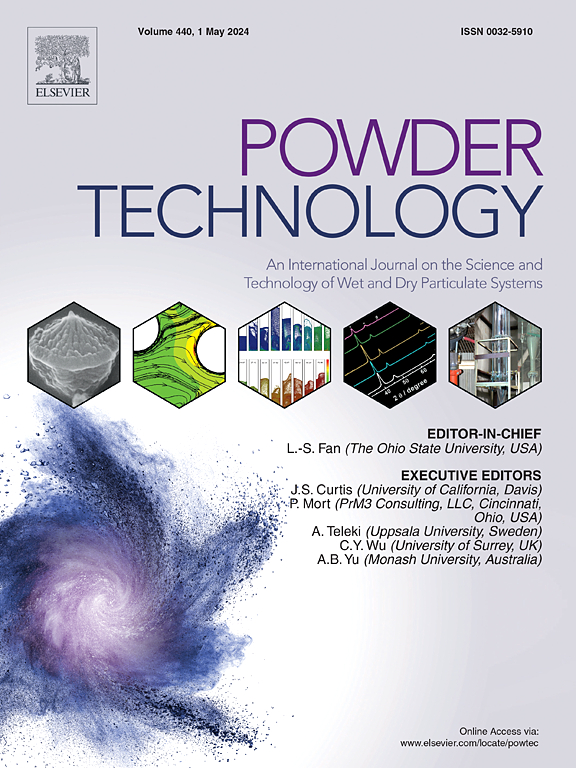实验验证的大变形粉末压实DEM:机械导出的接触模型和非物理接触的筛选
IF 4.5
2区 工程技术
Q2 ENGINEERING, CHEMICAL
引用次数: 0
摘要
尽管工业生产中普遍依赖粉末压实,但对导致孔隙结构、机械强度和缺陷的潜在物理机制的全面了解仍然难以捉摸,这对优化工艺和提高产品质量的持续努力构成了挑战。离散元法(DEM)是研究粉末压实的一个很有前途的工具,因为它的算法简单和粒子级的洞察力,但它的应用受到限制,缺乏可访问的,物理合理的大变形接触模型。在这项工作中,我们通过将最近提出的适用于大变形的机械衍生粘接弹塑性接触模型(Zunker和Kamrin, 2024, 2024)扩展到多相互作用粒子的情况来帮助解决这一问题。本文还提出了一种拓扑罚算法,用于筛选大变形DEM所特有的通过阻挡颗粒发生的非物理接触。在开源DEM软件LAMMPS (https://github.com/lammps/lammps)中实现了扩展版的接触模型和拓扑惩罚算法,并对多粒子有限元法(MPFEM)进行了验证。通过与有限元预测的比较,强调了接触模型重建变形颗粒形状的独特能力。模拟了制药压片的工业相关问题,并与Avicel PH102(微晶纤维素)压实的实验数据进行了比较。轴向和径向应力随相对密度的变化与数值模拟结果吻合较好。值得注意的是,模拟能够预测轴向围压释放后的残余径向应力与实验相似。本文章由计算机程序翻译,如有差异,请以英文原文为准。

Experimentally validated DEM for large deformation powder compaction: Mechanically-derived contact model and screening of non-physical contacts
Despite widespread industrial reliance on powder compaction in manufacturing, a complete understanding of the underlying physical mechanisms that lead to pore structure, mechanical strength, and defects remains elusive, challenging ongoing efforts to optimize the process and improve product quality. The discrete element method (DEM) is a promising tool for studying powder compaction due to its algorithmic simplicity and particle-level insights, but its application is limited by the lack of accessible, physically justified contact models for large deformations. In this work, we help address this problem by extending the recently proposed mechanically-derived adhesive elastic–plastic contact model (Zunker and Kamrin, 2024, 2024) suitable for large deformation to the case of many-interacting particles. A topological penalty algorithm for the screening of non-physical contacts occurring through obstructing particles, a phenomenon unique to large deformation DEM, is also proposed. The extended version of the contact model and topological penalty algorithm are implemented into the open-source DEM software LAMMPS (https://github.com/lammps/lammps) and validated against the multi-particle finite element method (MPFEM). The contact models unique ability to reconstruct deformed particle shapes is highlighted by comparison to FEM predictions. The industrially relevant problem of pharmaceutical tableting is simulated and comparisons to experimental data for the compaction of Avicel PH102 (microcrystalline cellulose) are made. Good agreement is observed between the experiment and numerical simulation for the axial and radial stress measurements as a function of relative density. Notably, the simulation is able to predict a similar residual radial stress after release of the axially confining pressure to that of the experiment.
求助全文
通过发布文献求助,成功后即可免费获取论文全文。
去求助
来源期刊

Powder Technology
工程技术-工程:化工
CiteScore
9.90
自引率
15.40%
发文量
1047
审稿时长
46 days
期刊介绍:
Powder Technology is an International Journal on the Science and Technology of Wet and Dry Particulate Systems. Powder Technology publishes papers on all aspects of the formation of particles and their characterisation and on the study of systems containing particulate solids. No limitation is imposed on the size of the particles, which may range from nanometre scale, as in pigments or aerosols, to that of mined or quarried materials. The following list of topics is not intended to be comprehensive, but rather to indicate typical subjects which fall within the scope of the journal's interests:
Formation and synthesis of particles by precipitation and other methods.
Modification of particles by agglomeration, coating, comminution and attrition.
Characterisation of the size, shape, surface area, pore structure and strength of particles and agglomerates (including the origins and effects of inter particle forces).
Packing, failure, flow and permeability of assemblies of particles.
Particle-particle interactions and suspension rheology.
Handling and processing operations such as slurry flow, fluidization, pneumatic conveying.
Interactions between particles and their environment, including delivery of particulate products to the body.
Applications of particle technology in production of pharmaceuticals, chemicals, foods, pigments, structural, and functional materials and in environmental and energy related matters.
For materials-oriented contributions we are looking for articles revealing the effect of particle/powder characteristics (size, morphology and composition, in that order) on material performance or functionality and, ideally, comparison to any industrial standard.
 求助内容:
求助内容: 应助结果提醒方式:
应助结果提醒方式:


